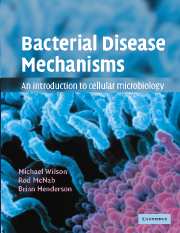Book contents
- Frontmatter
- Contents
- Preface
- Abbreviations used
- Chapter 1 An introduction to bacterial diseases
- Chapter 2 Bacterial cell biology
- Chapter 3 Molecular analysis of bacterial virulence mechanisms
- Chapter 4 Communication in infection
- Chapter 5 The mucosal surface: the front line of antibacterial defence
- Chapter 6 Immune defences against bacteria
- Chapter 7 Bacterial adhesion as a virulence mechanism
- Chapter 8 Bacterial invasion as a virulence mechanism
- Chapter 9 Bacterial exotoxins
- Chapter 10 Bacterial evasion of host defence mechanisms
- Chapter 11 Bacteria in human health and disease: the future?
- Appendix A Glossary of terms used
- Appendix B Brief descriptions of bacteria frequently mentioned
- Index
- Plate section
Chapter 4 - Communication in infection
Published online by Cambridge University Press: 05 June 2012
- Frontmatter
- Contents
- Preface
- Abbreviations used
- Chapter 1 An introduction to bacterial diseases
- Chapter 2 Bacterial cell biology
- Chapter 3 Molecular analysis of bacterial virulence mechanisms
- Chapter 4 Communication in infection
- Chapter 5 The mucosal surface: the front line of antibacterial defence
- Chapter 6 Immune defences against bacteria
- Chapter 7 Bacterial adhesion as a virulence mechanism
- Chapter 8 Bacterial invasion as a virulence mechanism
- Chapter 9 Bacterial exotoxins
- Chapter 10 Bacterial evasion of host defence mechanisms
- Chapter 11 Bacteria in human health and disease: the future?
- Appendix A Glossary of terms used
- Appendix B Brief descriptions of bacteria frequently mentioned
- Index
- Plate section
Summary
Aims
The main aims of this chapter are to introduce the reader to:
the concept of signalling in biology
the role of intracellular signalling in normal eukaiyotic cell control
eukaryotic intracellular signalling mechanisms
cell–cell signalling in eukaiyotes
the role of cytokines as cell–cell signalling controllers
prokaryotic intracellular signalling
prokaryotic cell–cell signalling
prokaryote–eukaryote cell signalling
the concept that bacteria manipulate eukaryotic signalling mechanisms to induce pathology
Introduction
Communication – the transfer of information – is part of our everyday lives and we are all participants in a rapidly expanding planet-wide communication experiment. It is also obvious that animals communicate – by using smell, sound and visual cues. The dawn chorus is a good example of animals signalling to each other. However, it may be less apparent that the maintenance of a multicellular organism is absolutely dependent on the correct transmission and reception of signals. To maintain the mammalian body in a healthy state requires an enormous number of signals. There are three major signalling systems in multicellular organisms and these are classified as neural, endocrine and cytokine. These individual systems also interact with each other in ways that are only now becoming apparent.
One way of looking at disease is as a disturbance in the signalling that generates the dynamically stable state known as homeostasis. This term defines the optimal conditions of the multitude of body systems required for normal functioning. Disturbances of endocrine hormone secretion, for example, are well-known causes of disease.
- Type
- Chapter
- Information
- Bacterial Disease MechanismsAn Introduction to Cellular Microbiology, pp. 162 - 237Publisher: Cambridge University PressPrint publication year: 2002



